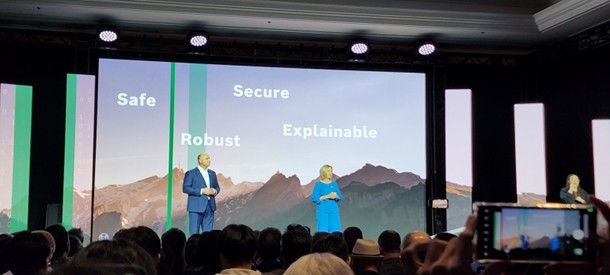
Welcome to SBD Automotive’s first daily #CES wrap-up for 2025! In addition to today’s insight, we’ll be publishing again Tuesday and Wednesday to share thoughts on what caught our team’s eye at the show for those of you following automotive & mobility news.
While most attendees descend on Las Vegas tonight or Tuesday morning, our team arrived early on Sunday to cover CES media days. Jeffrey Hannah and Andrew Wilcsyznski attended CES Unveiled on Sunday night, where SteerLight, Okular Logistics, Vox AI, SQ-Motors France, AutoVR, and Strutt caught our team’s eye.
But some big news is made today, Monday, as tech executives take over the Mandalay Bay hotel for media-only press briefings.
Toyota talks Woven City, but nothing about cars
At CES 2024, Hyundai and Kia stole the show with a wide range of announcements on hydrogen, software-defined vehicles, and the future of mobility with “Purpose-Built Vehicles”. This year, Toyota and Zeekr took their turn in the media spotlight.
In a 15-minute press conference, Toyota’s chairman and ex-CEO, Akio Toyoda, announced that Toyota completed “Phase 1” of Woven City construction near Mt. Fuji in Japan on October 31, 2024. Toyota broke ground on the site in February 2021.

Mr. Toyoda announced a population goal of 2,000 “Weavers” (residents) for the campus, with the first wave set to start moving in later in 2025. The city aims to recruit Toyota employees, retailers, entrepreneurs, retailers, visiting scientists, and other collaborative innovators to take advantage of the large R&D space available in its converted assembly plant. To us, the concept feels like a more residential-centric version of the work done by the Michigan Central team with the Detroit train station, Ford Motor Company, and Newlab.
Notably, Mr. Toyoda spent almost no time talking about the company’s automotive business outside of a short reference to the work of Woven by Toyota on in-vehicle software and autonomy. Instead, he spotlighted the work of Joby Aviation – an eVTOL company into which Toyota has invested north of $500 million.
Mr. Toyoda also announced that Toyota is exploring rocket development (with a backdrop of an image from Interstellar Rockets, a Japanese spaceflight company), winking that there will now be more than one “car company” going to space as part of its mobility strategy in an apparent nod to Tesla, SpaceX, and Elon Musk.
Our take? Toyota’s emphasis on everything but the car helps illustrate the challenge most automakers face. The industry faces massive upward cost pressure from its supply base while facing downward cost pressure from consumers and Chinese competition, leaving little room in the status quo for value creation and innovation. We expect to see a continued increase in automakers around the world increasing their investment in non-automotive forms of mobility.
Zeekr makes one of the largest Chinese OEMs presence since BYTON in 2019

Later in the day, in a much smaller ballroom, the Chinese EV brand Zeekr – a subsidiary of Geely which also owns Volvo and LYNK & CO - announced that it would supply the first-ever purpose-built electric vehicles to Alphabet’s Waymo starting in 2025. This follows initial announcement of the agreement in 2021, and TechCrunch reported that these vehicles have already been spotted in San Francisco earlier in 2024. This follows a similar order of (non-purpose-built) Hyundai IONIQ 5 EVs with deliveries also beginning in 2025.

Zeekr also took the opportunity to share a wealth of information on its AI Cockpit, software-defined vehicle efforts, digital experience capabilities, and ecosystem partnerships. We expect similar content from BMW and Honda.
On the show floor, Zeekr will be displaying its performance EV (001 FR), upscale minivan EV (009 Grand), and family van EV (Mix), which appears to also be the basis for the Waymo platform. These models have been previously announced by Zeekr.
One interesting note: Zeekr is the first Chinese automaker to have this significant of a presence at CES since now-defunct BYTON in 2019.
Sony opens $200 reservations for AFEELA, starting at $89,900

In the final press conference of the day, Sony announced pricing for the long-prototyped AFEELA 1 Origin ($89,900 and AFEELA 1 Signature ($102,900) sedans. The vehicles will be available in California to start, then to other states. A 3-year subscription inclusive of L2+ ADAS, in-vehicle streaming entertainment, customizable themes and the AFEELA personal agent is included in the sale price. Sony Honda Mobility expects to start deliveries in mid-2026 in California.
Our take? This car seems remarkably like the Lucid Air, but with the scale and reliability of Honda’s manufacturing footprint and Sony’s entertainment profile, it will have some specific advantages. Nonetheless, the AFEELA enters a deeply competitive high-end EV market and initial volumes will likely be low. This is probably intentional to give Sony and Honda more runway to work up to larger volumes at lower prices across more diverse markets.
CE Suppliers Inject AI to Automotive and the Smart Home
In addition to Toyota and Zeekr’s press conferences, consumer electronics suppliers had lots to say on Monday as well:

Bosch announced its wrong-way driver alert system in partnership with SiriusXM Connect, one of the most experienced connected vehicle companies in the world.
According to NHTSA, wrong-way incidents are among the most fatal types of accidents, with a nearly 80% fatality rate, while incident rates continue to increase.
Governments could consider making these types of alerts mandatory in coming years given the scale and danger of the problem, particularly in countries with aging populations like Japan, China and the United States. Bosch also announced that it has over 5,000 people working on AI across its businesses.

LG Electronics demonstrated its in-vehicle “affectionate intelligence” (LG AI) concept, leveraging Microsoft’s Copilot service. In-vehicle voice interaction remains a top use case for generative AI, but the level of performance required for seamless on-edge user experiences demands more capable on-device neural processing. Long lead times and the relatively high cost of NPU-equipped electronics means that it will take many years for this type of experience to reach mass-market through manufacturer-equipped silicon. This is why smartphone software companies like Apple and Google have a critical time advantage in voice AI (and why automakers have a love/hate relationship with CarPlay and Android Auto) – they offer a much lower barrier to entry for consumers.
Samsung, with its subsidiary Harman, showcased its in-vehicle AI-powered avatar and updates to the Ready Care and Ready Vision technology suites. Samsung spent most of its keynote spotlighting its Home AI solution, including ability to manage EV charging schedules based on utility rates and solar generation. Samsung has historically deferred most of its automotive buzz to Harman, which the company acquired in 2017. Harman often has an extensive automotive exhibit at the show and returns this year as part of the Samsung booth in LVCC Central Hall.
The word of the day is Trust

As we look ahead to the start of the show, we’re already sensing themes around the expansion of software-defined vehicle partnerships, AI capabilities built into edge devices, in-vehicle sensing, augmented reality, and both sustainability and electrification – more to come tomorrow on that. But the message that stood out to us most from today was Bosch’s emphasis on building trust in new technology through a paradigm of safe, secure, robust, and explainable. It’s easy to look at the concepts on display at CES and get excited about the potential use cases for the technology, but implementing this technology in a way that provides a seamless, reliable, safe, and secure user experience is much more difficult, particular for a nascent technology like generative AI.
Over the coming week, we will spotlight some companies that are showcasing responsible implementations of innovative technology that work towards building this trust through what we’re calling “4S mobility” – with each “S” standing for safe, secure, sustainable, and seamless. Stay tuned (wink, wink) and see you tomorrow!

P.S. – Don’t forget to check out our CES 2025 primer and show guide to help make the most of your time at the Las Vegas Convention Center and beyond.
